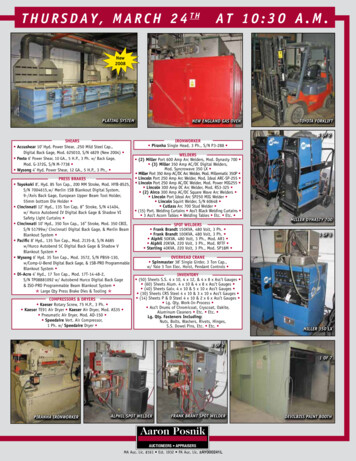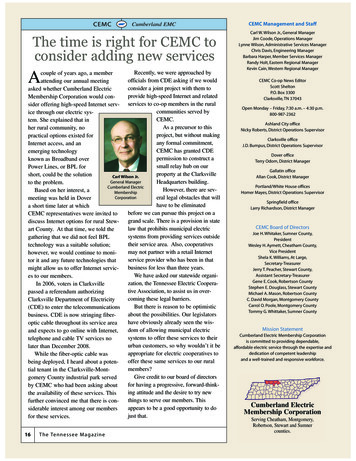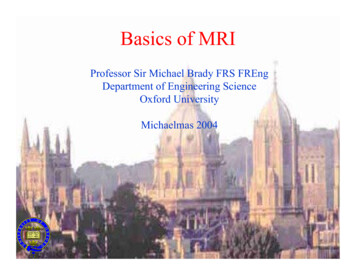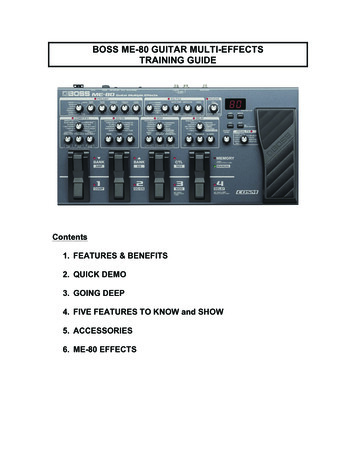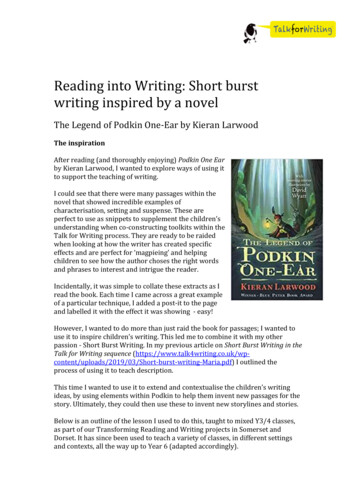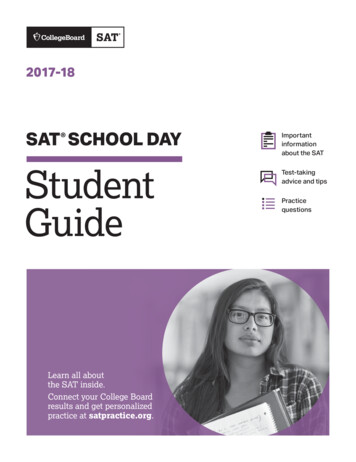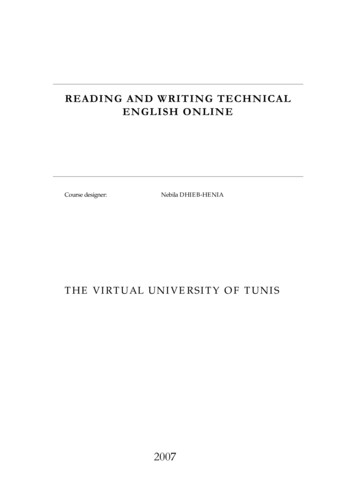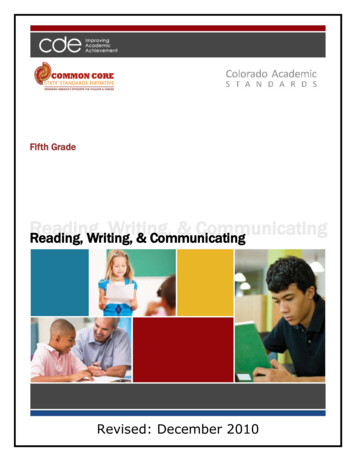
Transcription
Fifth GradeReading,Writing,&CommunicatingReading, Writing, & CommunicatingRevised: December 2010
Colorado Academic Standards inReading, Writing, and CommunicatingandThe Common Core State Standards for EnglishLanguage Arts & Literacy in History/Social Studies,Science, and Technical SubjectsOn December 10, 2009, the Colorado State Board of Education adopted the revised Reading, Writing,and Communicating Academic Standards, along with academic standards in nine other content areas,creating Colorado’s first fully aligned preschool through high school academic expectations. Developedby a broad spectrum of Coloradans representing Pre-K and K-12 education, higher education, andbusiness, utilizing the best national and international exemplars, the intention of these standards is toprepare Colorado schoolchildren for achievement at each grade level, and ultimately, for successfulperformance in postsecondary institutions and/or the workforce.Concurrent to the revision of the Colorado standards was the Common Core State Standards (CCSS)initiative, whose process and purpose significantly overlapped with that of the Colorado AcademicStandards. Led by the Council of Chief State School Officers (CCSSO) and the National GovernorsAssociation (NGA), these standards present a national perspective on academic expectations forstudents, Kindergarten through High School in the United States.In addition to standards in English Language Arts (ELA), the Common Core State Standards offerliteracy expectations for history/social studies, science, and technical subjects. These expectations,beginning in grade 6 through grade 12, are intended to assist teachers in “use(ing) their content areaexpertise to help students meet the particular challenges of reading, writing, speaking, listening, andlanguage in their respective fields.” (Common Core State Standards for English Language Arts &Literacy in History/Social Studies, Science, and Technical Subjects, page 3). These expectations areNOT meant to supplant academic standards in other content areas, but to be used as a literacysupplement.Upon the release of the Common Core State Standards for English Language Arts & Literacy inHistory/Social Studies, Science, and Technical Subjects on June 2, 2010, the Colorado Department ofEducation began a gap analysis process to determine the degree to which the expectations of theColorado Academic Standards aligned with the Common Core. The independent analysis proved anearly 95% alignment between the two sets of standards. On August 2, 2010, the Colorado StateBoard of Education adopted the Common Core State Standards, and requested the integration of theCommon Core State Standards and the Colorado Academic Standards.In partnership with the dedicated members of the Colorado Standards Revision Subcommittee inReading, Writing, and Communicating, this document represents the integration of the combinedacademic content of both sets of standards, maintaining the unique aspects of the Colorado AcademicStandards, which include personal financial literacy, 21 st century skills, school readiness competencies,postsecondary and workforce readiness competencies, and preschool expectations. The result is aworld-class set of standards that are greater than the sum of their parts.The Colorado Department of Education encourages you to review the Common Core State Standardsand the extensive appendices at www.corestandards.org. While all the expectations of the CommonCore State Standards are embedded and coded with CCSS: in this document, additional informationon the development and the intentions behind the Common Core State Standards can be found on thewebsite.CDE: 5th Grade Reading, Writing, and CommunicatingPage 2 of 27
Colorado Academic StandardsReading, Writing, and Communicating“Read not to contradict and confute; nor to believe and take for granted; nor to find talk anddiscourse; but to weigh and consider. Some books are to be tasted, others to be swallowed, and somefew to be chewed and digested .” --Francis Bacon "If you cannot write well, you cannot think well, and if you cannot think well, others will do yourthinking for you." --George Orwell A strong command of the language arts (reading, writing, speaking, and listening) is vital for being asuccessful student and ultimately a productive member of the 21 st century workforce. Language skillshave always been fundamental for academic and professional success. However, students in the 21 stcentury are now facing more complex challenges in an ever-changing global society. These challengeshave created the need for rigorous state standards in reading, writing, speaking, and listening.Literacy – meaning the ability to construe a written, linguistic, alphabetic symbol system – is arguablythe most important skill students acquire in preschool through twelfth-grade education because itmakes all other forms of higher-order learning, critical thinking, and communication possible.The study of reading, writing, and communicating is therefore essential to all other study in earlychildhood education, primary school, and secondary school. Such study comprises not only thefundamental knowledge and skills of language arts (reading, writing, speaking, and listening), but alsothe knowledge and skills of discourse (dialogue and discussion) and rhetoric (the ability to makearguments and to think critically about arguments made by others) and the knowledge and skillsinvolved in responding to imaginative literature.Language skills are necessary for academic success in all disciplines. The ability to integrate reading,writing, speaking, and listening effectively builds understanding across all academic subjects as well asallowing for the development of 21st century skills within the context of these subjects. Critical thinkingand reasoning, information literacy, collaboration, self-direction, and innovation are vital 21st centuryskills.Standards for reading, writing, and communicating in all grades must be clear and rigorous so that ourpublic educational system gives students the skills, knowledge, and confidence they need to succeed inpostsecondary education and the workforce, to be well-informed and responsible citizens, and to leadmore fulfilling personal lives.CDE: 5th Grade Reading, Writing, and CommunicatingPage 3 of 27
Standards Organization and ConstructionAs the subcommittee began the revision process to improve the existing standards, it became evidentthat the way the standards information was organized, defined, and constructed needed to changefrom the existing documents. The new design is intended to provide more clarity and direction forteachers, and to show how 21st century skills and the elements of school readiness and postsecondaryand workforce readiness indicators give depth and context to essential learning.The “Continuum of State Standards Definitions” section that follows shows the hierarchical order of thestandards components. The “Standards Template” section demonstrates how this continuum is put intopractice.The elements of the revised standards are:Prepared Graduate Competencies: The preschool through twelfth-grade concepts and skills that allstudents who complete the Colorado education system must master to ensure their success in apostsecondary and workforce setting.Standard: The topical organization of an academic content area.High School Expectations: The articulation of the concepts and skills of a standard that indicates astudent is making progress toward being a prepared graduate. What do students need to know in highschool?Grade Level Expectations: The articulation (at each grade level), concepts, and skills of a standardthat indicate a student is making progress toward being ready for high school. What do students needto know from preschool through eighth grade?Evidence Outcomes: The indication that a student is meeting an expectation at the mastery level.How do we know that a student can do it?21st Century Skills and Readiness Competencies: Includes the following:Inquiry Questions:Sample questions are intended to promote deeper thinking,understandings precisely related to the grade level expectation.reflectionandrefinedRelevance and Application:Examples of how the grade level expectation is applied at home, on the job or in a real-world,relevant context.Nature of the Discipline:The characteristics and viewpoint one keeps as a result of mastering the grade levelexpectation.CDE: 5th Grade Reading, Writing, and CommunicatingPage 4 of 27
Continuum of State Standards DefinitionsPrepared Graduate CompetencyPrepared Graduate Competencies are the P12 concepts and skills that all studentsleaving the Colorado education system musthave to ensure success in a postsecondaryand workforce setting.StandardsStandards are the topical organization of anacademic content area.P-8High SchoolGrade Level ExpectationsExpectations articulate, at each gradelevel, the knowledge and skills of astandard that indicates a student ismaking progress toward high school.What do students need to know?EvidenceOutcomesEvidence outcomesare the indicationthat a student ismeeting anexpectation at themastery level.How do we know thata student can do it?21st Century andPWR SkillsInquiry Questions:Sample questions intendedto promote deeper thinking,reflection and refinedunderstandings preciselyrelated to the grade levelexpectation.Relevance andApplication:Examples of how the gradelevel expectation is appliedat home, on the job or in areal-world, relevant context.Nature of theDiscipline:The characteristics andviewpoint one keeps as aresult of mastering the gradelevel expectation.CDE: 5th Grade Reading, Writing, and CommunicatingHigh School ExpectationsExpectations articulate the knowledgeand skills of a standard that indicates astudent is making progress towardbeing a prepared graduate.What do students need to know?EvidenceOutcomesEvidence outcomesare the indicationthat a student ismeeting anexpectation at themastery level.How do we know thata student can do it?21st Century andPWR SkillsInquiry Questions:Sample questions intendedto promote deeper thinking,reflection and refinedunderstandings preciselyrelated to the grade levelexpectation.Relevance andApplication:Examples of how the gradelevel expectation is appliedat home, on the job or in areal-world, relevant context.Nature of theDiscipline:The characteristics andviewpoint one keeps as aresult of mastering thegrade level expectation.Page 5 of 27
STANDARDS TEMPLATEContent Area: NAME OF CONTENT AREAStandard: The topical organization of an academic content area.Prepared Graduates: The P-12 concepts and skills that all students leaving the Colorado education system must have to ensuresuccess in a postsecondary and workforce setting.High School and Grade Level ExpectationsConcepts and skills students master:Grade Level Expectation: High Schools: The articulation of the concepts and skills of a standard that indicates astudent is making progress toward being a prepared graduate.Grade Level Expectations: The articulation, at each grade level, the concepts and skills of a standard thatindicates a student is making progress toward being ready for high school.What do students need to know?Evidence Outcomes21st Century Skills and Readiness CompetenciesStudents can:Inquiry Questions:Evidence outcomes are the indicationthat a student is meeting anexpectation at the mastery level.Sample questions intended to promote deeper thinking, reflection andrefined understandings precisely related to the grade level expectation.How do we know that a student cando it?Relevance and Application:Examples of how the grade level expectation is applied at home, on thejob or in a real-world, relevant context.Nature of the Discipline:The characteristics and viewpoint one keeps as a result of mastering thegrade level expectation.Colorado Department of Education: 5th Grade Reading, Writing, and CommunicatingRevised: December 2010Page 6 of 27
Prepared Graduate Competenciesin Reading, Writing, and CommunicatingThe preschool through twelfth-grade concepts and skills that all students who complete the Coloradoeducation system must master to ensure their success in a postsecondary and workforce setting.Prepared Graduates: Collaborate effectively as group members or leaders who listen actively and respectfully posethoughtful questions, acknowledge the ideas of others, and contribute ideas to further thegroup’s attainment of an objective Deliver organized and effective oral presentations for diverse audiences and varied purposes Use language appropriate for purpose and audience Demonstrate skill in inferential and evaluative listening Interpret how the structure of written English contributes to the pronunciation and meaning ofcomplex vocabulary Demonstrate comprehension of a variety of informational, literary, and persuasive texts Evaluate how an author uses words to create mental imagery, suggest mood, and set tone Read a wide range of literature (American and world literature) to understand importantuniversal themes and the human experience Seek feedback, self-assess, and reflect on personal learning while engaging with increasinglymore difficult texts Engage in a wide range of nonfiction and real-life reading experiences to solve problems, judgethe quality of ideas, or complete daily tasks Write with a clear focus, coherent organization, sufficient elaboration, and detail Effectively use content-specific language, style, tone, and text structure to compose or adaptwriting for different audiences and purposes Apply standard English conventions to effectively communicate with written language Implement the writing process successfully to plan, revise, and edit written work Master the techniques of effective informational, literary, and persuasive writing Discriminate and justify a position using traditional lines of rhetorical argument and reasoning Articulate the position of self and others using experiential and material logic Gather information from a variety of sources; analyze and evaluate the quality and relevance ofthe source; and use it to answer complex questions Use primary, secondary, and tertiary written sources to generate and answer researchquestions Evaluate explicit and implicit viewpoints, values, attitudes, and assumptions concealed inspeech, writing, and illustration Demonstrate the use of a range of strategies, research techniques, and persistence whenengaging with difficult texts or examining complex problems or issues Exercise ethical conduct when writing, researching, and documenting sourcesCDE: 5th Grade Reading, Writing, and CommunicatingPage 7 of 27
Standards in Reading, Writing, and CommunicatingStandards are the topical organization of an academic content area. The four standards of Reading,Writing, and Communicating are:1. Oral Expression and ListeningLearning of word meanings occurs rapidly from birth through adolescence within communicativerelationships. Everyday interactions with parents, teachers, peers, friends, and communitymembers shape speech habits and knowledge of language. Language is the means to highermental functioning, that which is a species-specific skill, unique to humans as a generativemeans for thinking and communication. Through linguistic oral communication, logical thinkingdevelops and makes possible critical thinking, reasoning, development of information literacy,application of collaboration skills, self-direction, and invention.Oral language foundation and written symbol systems concretize the way a studentcommunicates. Thus, students in Colorado develop oral language skills in listening andspeaking, and master the written language skills of reading and writing. Specifically, holdingColorado students accountable for language mastery from the perspectives of scientificresearch in linguistics, cognitive psychology, human information processing, brain-behaviorrelationships, and socio-cultural perspectives on language development will allow students tomaster 21st century skills and serve the state, region, and nation well.2. Reading for All PurposesLiteracy skills are essential for students to fully participate in and expand their understanding oftoday’s global society. Whether they are reading functional texts (voting ballots, a map, a trainschedule, a driver’s test, a job application, a text message, product labels); reference materials(textbooks, technical manuals, electronic media); or print and non-print literary texts, studentsneed reading skills to fully manage, evaluate, and use the myriad information available in theirday-to-day lives.3. Writing and CompositionWriting is a fundamental component of literacy. Writing is a means of critical inquiry; itpromotes problem solving and mastering new concepts. Adept writers can work through variousideas while producing informational, persuasive, and narrative or literary texts. In other words,writing can be used as a medium for reasoning and making intellectual connections. Asstudents arrange ideas to persuade, describe, and inform, they engage in logical critique, andthey are likely to gain new insights and a deeper understanding of concepts and content.4. Research and ReasoningResearch and Reasoning skills are pertinent for success in a postsecondary and workforcesetting. Students need to acquire these skills throughout their schooling. This means studentsneed to be able to distinguish their own ideas from information created or discovered by others,understand the importance of creating authentic works, and correctly cite sources to give creditto the author of the original work.The Common Core State Standards for English Language Arts & Literacy in History/Social Studies,Science and Technical Subjects include a separate standard for Language. In this document, thoseLanguage expectations are integrated into the four standards above as appropriate.CDE: 5th Grade Reading, Writing, and CommunicatingPage 8 of 27
Reading, Writing, and CommunicatingGrade Level Expectations at a GlanceStandardGrade Level ExpectationFifth Grade1. Oral Expressionand Listening1.2.2. Reading for AllPurposes1.2.3.3. Writing andComposition1.2.4. Research andReasoning3.1.2.3.Effective communication requires speakers to express an opinion,provide information, describe a process, and persuade an audienceListening strategies are techniques that contribute to understandingdifferent situations and serving different purposesLiterary texts are understood and interpreted using a range ofstrategiesIdeas found in a variety of informational texts need to be comparedand understoodKnowledge of morphology and word relationships matters whenreadingThe recursive writing process contributes to the creative and uniqueliterary genres for a variety of audiences and purposesThe recursive writing process creates stronger informational andpersuasive texts for a variety of audiences and purposesConventions apply consistently when evaluating written textsHigh-quality research requires information that is organized andpresented with documentationIdentifying and evaluating concepts and ideas have implications andconsequencesQuality reasoning requires asking questions and analyzing andevaluating viewpointsCDE: 5th Grade Reading, Writing, and CommunicatingPage 9 of 27
21st Century Skills and Readiness Competenciesin Reading, Writing, and CommunicatingThe reading, writing, and communicating subcommittee embedded 21 st century skills, schoolreadiness, and postsecondary and workforce readiness skills into the revised standards utilizingdescriptions developed by Coloradans and vetted by educators, policymakers, and citizens.Colorado's Description of 21st Century SkillsThe 21st century skills are the synthesis of the essential abilities students must apply in our rapidlychanging world. Today’s students need a repertoire of knowledge and skills that are more diverse,complex, and integrated than any previous generation. Reading, Writing, and Communicating areinherently demonstrated in each of Colorado’s 21st century skills, as follows:Critical Thinking and ReasoningCritical thinking and reasoning are vital to advance in the technologically sophisticated world we live in.In order for students to be successful and powerful readers, writers, and communicators, they mustincorporate critical thinking and reasoning skills. Students need to be able to successfully argue apoint, justify reasoning, evaluate for a purpose, infer to predict and draw conclusions, problem-solve,and understand and use logic to inform critical thinking.Information LiteracyThe student who is information-literate accesses information efficiently and effectively by reading andunderstanding essential content of a range of informational texts and documents in all academic areas.This involves evaluating information critically and competently; accessing appropriate tools tosynthesize information; recognizing relevant primary and secondary information; and distinguishingamong fact, point of view, and opinion.CollaborationReading, writing, and communicating must encompass collaboration skills. Students should be able tocollaborate with each other in multiple settings: peer groups, one-on-one, in front of an audience, inlarge and small group settings, and with people of other ethnicities. Students should be able toparticipate in a peer review, foster a safe environment for discourse, mediate opposing perspectives,contribute ideas, speak with a purpose, understand and apply knowledge of culture, and seek others’ideas.Self DirectionStudents who read, write, and communicate independently portray self-direction by usingmetacognition skills. These important skills are a learner’s automatic awareness of knowledge andability to understand, control, and manipulate cognitive processes. These skills are important not onlyin school but throughout life, enabling the student to learn and set goals independently.InventionApplying new ways to solve problems is an ideal in reading and writing instruction. Invention is one ofthe key components of creating an exemplary writing piece or synthesizing information from multiplesources. Invention takes students to a higher level of metacognition while exploring literature andwriting about their experiences.CDE: 5th Grade Reading, Writing, and CommunicatingPage 10 of 27
Colorado’s Description for School Readiness(Adopted by the State Board of Education, December 2008)School readiness describes both the preparedness of a child to engage in and benefit from learningexperiences, and the ability of a school to meet the needs of all students enrolled in publicly fundedpreschools or kindergartens. School readiness is enhanced when schools, families, and communityservice providers work collaboratively to ensure that every child is ready for higher levels of learning inacademic content.Colorado’s Description of Postsecondary and Workforce Readiness(Adopted by the State Board of Education, June 2009)Postsecondary and workforce readiness describes the knowledge, skills, and behaviors essential forhigh school graduates to be prepared to enter college and the workforce and to compete in the globaleconomy. The description assumes students have developed consistent intellectual growth throughouttheir high school career as a result of academic work that is increasingly challenging, engaging, andcoherent. Postsecondary education and workforce readiness assumes that students are ready and ableto demonstrate the following without the need for remediation: Critical thinking and problem-solving;finding and using information/information technology; creativity and innovation; global and culturalawareness; civic responsibility; work ethic; personal responsibility; communication; and collaboration.How These Skills and Competencies are Embedded in the Revised StandardsThree themes are used to describe these important skills and competencies and are interwoventhroughout the standards: inquiry questions; relevance and application; and the nature of eachdiscipline. These competencies should not be thought of stand-alone concepts, but should beintegrated throughout the curriculum in all grade levels. Just as it is impossible to teach thinking skillsto students without the content to think about, it is equally impossible for students to understand thecontent of a discipline without grappling with complex questions and the investigation of topics.Inquiry Questions – Inquiry is a multifaceted process requiring students to think and pursueunderstanding. Inquiry demands that students (a) engage in an active observation and questioningprocess; (b) investigate to gather evidence; (c) formulate explanations based on evidence; (d)communicate and justify explanations, and; (e) reflect and refine ideas. Inquiry is more than hands-onactivities; it requires students to cognitively wrestle with core concepts as they make sense of newideas.Relevance and Application – The hallmark of learning a discipline is the ability to apply theknowledge, skills, and concepts in real-world, relevant contexts. Components of this include solvingproblems, developing, adapting, and refining solutions for the betterment of society. The application ofa discipline, including how technology assists or accelerates the work, enables students to more fullyappreciate how the mastery of the grade level expectation matters after formal schooling is complete.Nature of Discipline – The unique advantage of a discipline is the perspective it gives the mind tosee the world and situations differently. The characteristics and viewpoint one keeps as a result ofmastering the grade level expectation is the nature of the discipline retained in the mind’s eye.CDE: 5th Grade Reading, Writing, and CommunicatingPage 11 of 27
1. Oral Expression and ListeningLearning of word meanings occurs rapidly from birth through adolescence within communicative relationships.Everyday interactions with parents, teachers, peers, friends, and community members shape speech habitsand knowledge of language. Language is the means to higher mental functioning, that which is a speciesspecific skill, unique to humans as a generative means for thinking and communication. Through linguisticoral communication, logical thinking develops and makes possible critical thinking, reasoning, development ofinformation literacy, application of collaboration skills, self-direction, and invention.Oral language foundation and written symbol systems concretize the way a student communicates. Thus,students in Colorado develop oral language skills in listening and speaking, and master the written languageskills of reading and writing. Specifically, holding Colorado students accountable for language mastery fromthe perspectives of scientific research in linguistics, cognitive psychology, human information processing,brain-behavior relationships, and socio-cultural perspectives on language development will allow students tomaster 21st century skills and serve the state, region, and nation well.Prepared Graduate CompetenciesThe preschool through grade 12 concepts and skills that all students who complete the Colorado educationsystem must master to ensure their success in a postsecondary and workforce setting.Prepared Graduate Competencies in the Oral Expression and Listening Standard: Collaborate effectively as group members or leaders who listen actively and respectfullypose thoughtful questions, acknowledge the ideas of others, and contribute ideas tofurther the group’s attainment of an objective Deliver organized and effective oral presentations for diverse audiences and variedpurposes Use language appropriate for purpose and audience Demonstrate skill in inferential and evaluative listeningColorado Department of Education: 5th Grade Reading, Writing, and CommunicatingRevised: December 2010Page 12 of 27
Content Area: Reading, Writing, and CommunicatingStandard: 1. Oral Expression and ListeningPrepared Graduates: Use language appropriate for purpose and audience Deliver organized and effective oral presentations for diverse audiences and varied purposesGrade Level Expectation: Fifth GradeConcepts and skills students master:1. Effective communication requires speakers to express an opinion, provide information,describe a process, and persuade an audienceEvidence Outcomes21st Century Skills and Readiness CompetenciesStudents can:a. Describe a process and persuade an audiencei. Report on a topic or text or present an opinion, sequencingideas logically and using appropriate facts and relevant,descriptive details to support main ideas or themes. (CCSS:SL.5.4)ii. Use appropriate eye contact and speak clearly at anunderstandable pace. (CCSS: SL.5.4)b. Include multimedia components (e.g., graphics, sound) andvisual displays in presentations when appropriate to enhancethe development of main ideas or themes. (CCSS: SL.5.5)c. Adapt speech to a variety of contexts and tasks. (CCSS: SL.5.6)d. Adapt language as appropriate to purpose: to persuade,explain/provide information, or express an opinion.Inquiry Questions:1. How do presenters make themselves clear when presentingideas to others?2. How do presenters make a good impression when speakingwith others?3. When presenters want to persuade audience members, whatis important for them to remember?Relevance and Application:1. Performing artists rehearse to perfect a performance beforepresenting to an audience.2. Video-recording and then viewing a presentation can helpspeakers understand what they do well and what they need toimprove.3. Advertising agencies develop media campaigns (for TV, radio,the Internet, newspapers, and magazines) to persuade peopleto buy their products.4. Online resources offer samples of language use from diversebackgrounds.5. Webinars allow sharing among and between a broaderaudience.Nature of Reading, Writing, and Communicating:1. Effective communicators can present
literacy expectations for history/social studies, science, and technical subjects. These expectations, beginning in grade 6 through grade 12, are intended to assist teachers in "use(ing) their content area expertise to help students meet the particular challenges of reading, writing, speaking, listening, and


